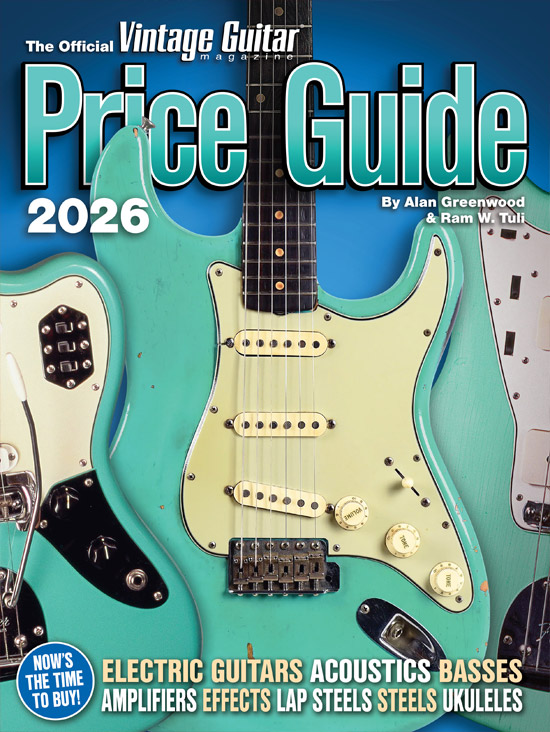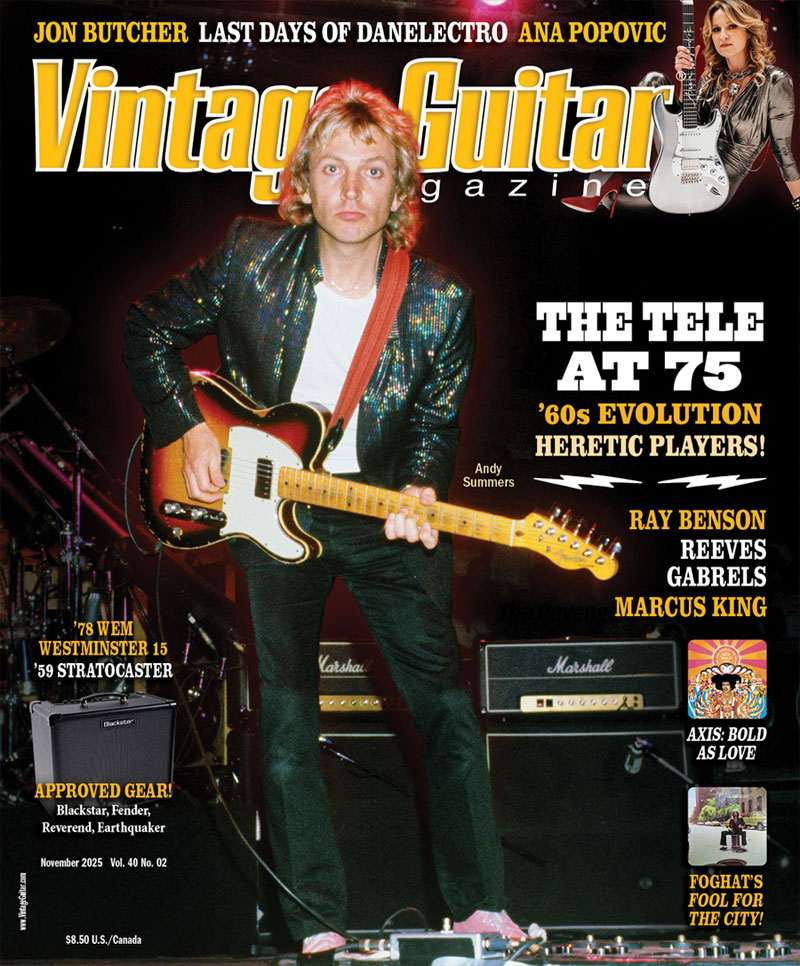
I have a Fender Precision Bass with a 1971 neck date and serial number 296XXX, and I’ve always suspected the body was mahogany rather than the typical ash or alder. My luthier agrees, and noted that the finish is lacquer. I’ve looked, and it seems a few Fenders of that era were indeed mahogany. I’m hoping you can shed some light on how common these are, and if the value differs from a Precision made of alder or ash. – Roger Hill
The finish wear on your Precision appears to show mahogany, and the overall darkness of the finish (along with the grain pattern) are consistent with mahogany. The nitro finish, however, is a cause for concern, because the neck date of ’71 is two/three years after Fender switched from nitro to polyurethane. That raises three possibilities; the body could be older with original nitro, it could be from ’71 and refinished, or it could be a replacement body from a later date. A closer analysis of the finish might shed some light, and the pots and pickups may provide a clue to originality.
Regarding value, you have an example where the rarity of the variation may be offset by lower demand. In other words, yes, a mahogany body is rare, but would anyone prefer it over the standard ash? There is certainly a degree of curiosity and speculation that a mahogany body might sound warmer than ash, and a mahogany Precision might fill a hole in someone’s collection, so a dealer might ask a bit more for it. – Walter Carter

I just acquired a used and abused Conrad 12-string from the late ’60s. It’s a quality instrument, and after I installed a tailpiece, it plays reasonably well with excellent tone. The top is spruce and the back and sides are, I believe, rosewood. I would appreciate any information you could discover. – Jack O’Garragh
That’s Conrad’s 12-String Folk Guitar, and you’re right, it’s from the late ’60s. Conrad was the house brand of David Wexler & Company, a distributor in Chicago. Music distributors back then assembled large inventories of all kinds of musical merchandise and sold them to retail stores. David Wexler began as a Victrola parts (springs for wind-up record players) salesman in 1920. According to a Music Trade Review notice in 1930, he also sold musical goods for Targ & Dinner, another large Chicago distributor.
Whether Wexler sold instruments under his own company name prior to World War II is unknown, but by 1946, David Wexler & Co. was selling American-made Wabash budget acoustic guitars and Whitehall drums. Circa ’58, Wexler was selling Goya guitars made by the Swedish company Levin.
Just when Wexler & Co. started importing guitars from Japan is uncertain, but they were doing so by ’65. Most Conrad electrics along with a few classicals and ukuleles were made by Kasuga. By ’67, Wexler had a full acoustic “Folk” lineup that included the 12-String, which had laminated-mahogany back and sides. Since your guitar has a two-piece laminated Indian rosewood back, it would most likely have been made after ’67. By ’73, Conrad 12-strings had changed to three-piece rosewood/maple/rosewood backs.
It’s not possible to date Japanese guitars from this era precisely because they did not have serial numbers. And it’s almost impossible to determine who made this guitar; there were several quality acoustic makers in Japan during this period. Some would ally themselves with a trading company that handled distribution, exporting, and other business matters. American distributors like Wexler would contract for certain numbers of each kind of guitar and the trading company would distribute the order components to appropriate makers within its family network. If the American distributor had a house brand such as Wexler’s Conrad, it would be applied.

Conrad guitars did not survive the ’70s and the famous “lawsuit” that ended the copying of American guitar designs. Today, David Wexler & Co. and the Conrad brand name are located in Scottsdale, Arizona, and specialize in musical items and accessories for school music programs, not guitars or drums. – Michael Wright
I recently inherited a ’65 ES-345TD-SV. I would like my kids and grandkids to play it, and I’m curious whether it would be advantageous to convert it to mono or to leave it as is? – Jim Baker
The only way to ensure the guitar retains its full market value is to leave it as-is; any modification will result in value loss and remove the instrument from consideration by serious collectors. Converting a stereo guitar like yours to mono would mean devaluation by as much as 20 percent, and while some mods are reversible, the work nonetheless remains detectable to the educated observer, so they are essentially permanent.
There is more than one way to modify a vintage 345. The most-expensive (which would cause the least loss of value) would be to remove the entire set of original electronics (pickups, potentiometers, switch, output jack, etc.) without breaking any solder joints and replacing them with modern components. This could be reversed with the least detectability. The least-expensive method (resulting in greatest loss of value and most detectability) would be to modify the wiring harness by cutting leads, re-soldering joints, and replacing the output jack. In either case, it’s wise to properly store the original parts.
If you’d prefer to play it mono, all you really need to do is use a stereo Y cord and plug both outputs into the same channel on an amp.
This article originally appeared in VG’s October 2024 issue. All copyrights are by the author and Vintage Guitar magazine. Unauthorized replication or use is strictly prohibited.



